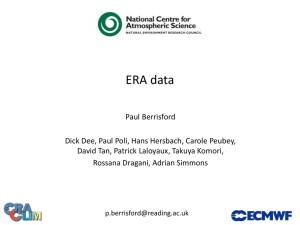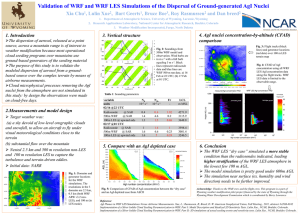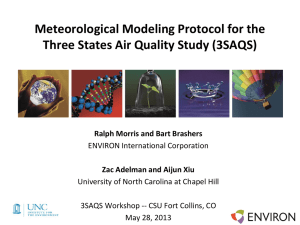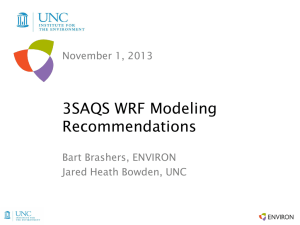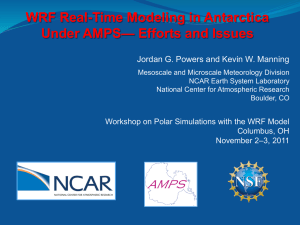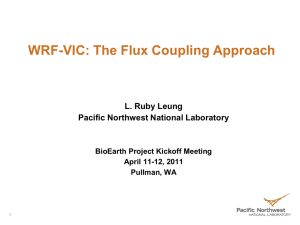CORDEX Arctic Simulations: Initial Results from the Weather
advertisement
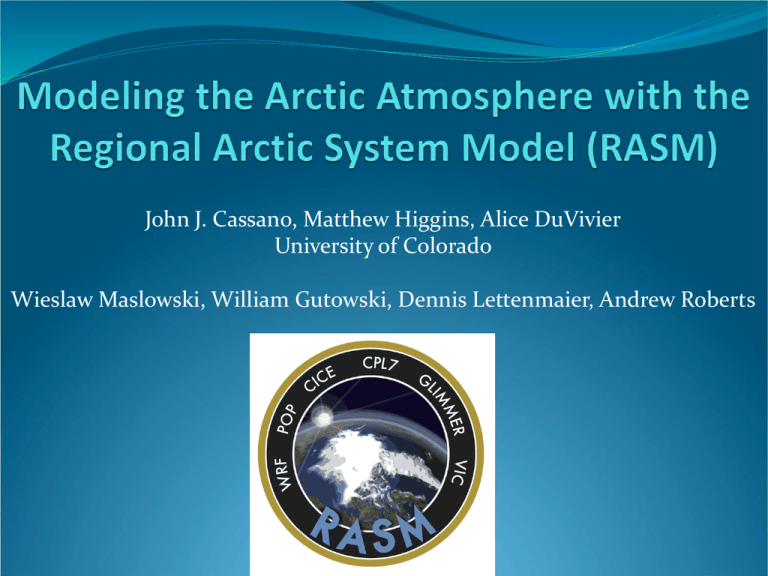
John J. Cassano, Matthew Higgins, Alice DuVivier University of Colorado Wieslaw Maslowski, William Gutowski, Dennis Lettenmaier, Andrew Roberts Project goals Develop a state-of-the-science regional Arctic system model (RASM) Why do we want a high resolution atmospheric model in RASM? The atmosphere forces and is forced by all other components of the climate system Small-scale features in the atmosphere can have large impacts on climatically important processes such as: Cyclone intensity / polar lows Mesoscale features such as topographically forced winds (Greenland tip jets) Realistic representation of these processes is critical for improved climate projection Cyclone Intensity and Size Resolution impacts the size and intensity of cyclones AMPS simulates lower pressure and smaller cyclones than all reanalyses Stronger and smaller storms will impact air-sea coupling as well as impact human activities in polar regions Mesoscale Features: Greenland tip jets Topographically forced mesoscale winds can be very strong but are poorly resolved in low resolution models These winds drive large sensible and latent heat fluxes 10 m wind speed (2/21/07) WRF Tip Jet Case Observed and Modeled Wind Speed a) b) c) d) e) Two Month: WRF average latent heat flux a) b) c) d) Two Month: WRF 95th percentile latent heat flux a) b) c) d) RACM simulations Coupled: Regional Arctic Climate Model (RACM) WRF – POP – CICE - VIC Simulation from 1989 to 2002 (currently) Atmosphere – land : WRF – Noah CORDEX simulation from 1989 to 2009 RACM and WRF simulations forced with: ERA-Interim IBC/LBCs Observed sea ice Use spectral nudging of wave numbers 1 and 2 Comparison presented here will focus on 1990 to 2002 Coupling Problems: Precipitation (Jan and July 1990) Coupling Problems: Tsfc Impacts (July 1990) Coupling Problems: SLP Impacts (July 1990) Sea Level Pressure 1989-2002 DJF Climatology ERA-Interim RACM WRF ERA-Interim & RACM RACM – ERA-Interim WRF – ERA-Interim Sea Level Pressure 1989-2002 JJA Climatology ERA-Interim ERA-Interim & RACM RACM WRF RACM – ERA-Interim WRF – ERA-Interim SLP and Sea Ice 1989-2002 JJA Climatology ERA-Interim ERA-Interim & RACM RACM RACM – ERA-Interim RACM - NSIDC Near Surface Temperature 1989-2002 JJA and DJF Climatology RACM – ERA-Interim JJA WRF – ERA-Interim JJA RACM – ERA-Interim DJF WRF – ERA-Interim DJF Temperature Profiles Northern Alaska 1989-2002 DJF Climatology Height RACM – ERA-Interim DJF WRF RACM Temperature Part of Russia Height Height North of 80 Latitude WRF RACM Temperature WRF RACM Temperature Precipitation and Snow Cover 1989-2002 DJF Climatology RACM – ERA-Interim DJF WRF – ERA-Interim DJF RACM – WRF DJF Precipitation Difference (%) RACM – ERA-Interim DJF WRF – ERA-Interim DJF Snow Water Equivalent Difference (kg m-2) RACM – WRF DJF Conclusions Use RASM to explore the impact of small-scale atmospheric processes on the coupled climate system Greenland tip jet showed large change in surface heat fluxes with increased resolution Care must be taken when coupling model components Precipitation problem in early versions of RACM Current version of RACM is stable Errors in coupled simulations are similar to those in atmosphere-only simulations, with some errors reduced in the coupled simulations Next Steps • Resolve issue with land temperature bias • Complete 20+ year fully coupled simulation (1989 to present) baseline simulation o Evaluation of baseline simulation • Multi-decadal simulations o Retrospective o Future climate o Regional simulations for CORDEX / AR5 Next Steps • Implementation of additional system components o Ice sheets o Dynamic vegetation climate
